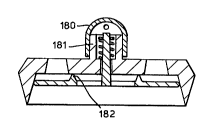Some of the information on this Web page has been provided by external sources. The Government of Canada is not responsible for the accuracy, reliability or currency of the information supplied by external sources. Users wishing to rely upon this information should consult directly with the source of the information. Content provided by external sources is not subject to official languages, privacy and accessibility requirements.
Any discrepancies in the text and image of the Claims and Abstract are due to differing posting times. Text of the Claims and Abstract are posted:
| (12) Patent Application: | (11) CA 2180269 |
|---|---|
| (54) English Title: | OVERFLOW PREVENTER |
| (54) French Title: | OBTURATEUR POUR TROP-PLEIN |
| Status: | Dead |
| (51) International Patent Classification (IPC): |
|
|---|---|
| (72) Inventors : |
|
| (73) Owners : |
|
| (71) Applicants : |
|
| (74) Agent: | OYEN WIGGS GREEN & MUTALA |
| (74) Associate agent: | |
| (45) Issued: | |
| (86) PCT Filing Date: | 1995-01-04 |
| (87) Open to Public Inspection: | 1995-07-13 |
| Availability of licence: | N/A |
| (25) Language of filing: | English |
| Patent Cooperation Treaty (PCT): | Yes |
|---|---|
| (86) PCT Filing Number: | PCT/GB1995/000007 |
| (87) International Publication Number: | WO1995/018896 |
| (85) National Entry: | 1996-06-28 |
| (30) Application Priority Data: | |||||||||
|---|---|---|---|---|---|---|---|---|---|
|
An overflow preventer comprising a plug receiv-
able in a drain hole and provided with a valve movable
between a first closed position and a second open posi-
tion, the valve being resiliently biased to the first position
while the pressure on the valve is less than a predeter-
mined value.
Ce dispositif pour trop-plein comprend un bouchon logeable dans un trou de vidange et pourvu d'une soupape susceptible de se déplacer d'une première position dans laquelle elle est fermée, vers une seconde position dans laquelle elle est ouverte, cette soupape étant sollicitée souplement vers sa première position lorsque la pression exercée sur elle est inférieure à une valeur prédéterminée.
Note: Claims are shown in the official language in which they were submitted.
Note: Descriptions are shown in the official language in which they were submitted.

For a clearer understanding of the status of the application/patent presented on this page, the site Disclaimer , as well as the definitions for Patent , Administrative Status , Maintenance Fee and Payment History should be consulted.
| Title | Date |
|---|---|
| Forecasted Issue Date | Unavailable |
| (86) PCT Filing Date | 1995-01-04 |
| (87) PCT Publication Date | 1995-07-13 |
| (85) National Entry | 1996-06-28 |
| Dead Application | 2003-01-06 |
| Abandonment Date | Reason | Reinstatement Date |
|---|---|---|
| 1999-01-04 | FAILURE TO PAY APPLICATION MAINTENANCE FEE | 1999-08-09 |
| 2000-01-04 | FAILURE TO PAY APPLICATION MAINTENANCE FEE | 2000-01-07 |
| 2002-01-04 | FAILURE TO PAY APPLICATION MAINTENANCE FEE | |
| 2002-01-04 | FAILURE TO REQUEST EXAMINATION |
| Fee Type | Anniversary Year | Due Date | Amount Paid | Paid Date |
|---|---|---|---|---|
| Application Fee | $0.00 | 1996-06-28 | ||
| Maintenance Fee - Application - New Act | 2 | 1997-01-06 | $50.00 | 1996-11-29 |
| Maintenance Fee - Application - New Act | 3 | 1998-01-05 | $50.00 | 1997-12-10 |
| Reinstatement: Failure to Pay Application Maintenance Fees | $200.00 | 1999-08-09 | ||
| Maintenance Fee - Application - New Act | 4 | 1999-01-04 | $50.00 | 1999-08-09 |
| Reinstatement: Failure to Pay Application Maintenance Fees | $200.00 | 2000-01-07 | ||
| Maintenance Fee - Application - New Act | 5 | 2000-01-04 | $75.00 | 2000-01-07 |
| Maintenance Fee - Application - New Act | 6 | 2001-01-04 | $75.00 | 2000-12-20 |
Note: Records showing the ownership history in alphabetical order.
| Current Owners on Record |
|---|
| BLANEY, TREVOR |
| Past Owners on Record |
|---|
| None |